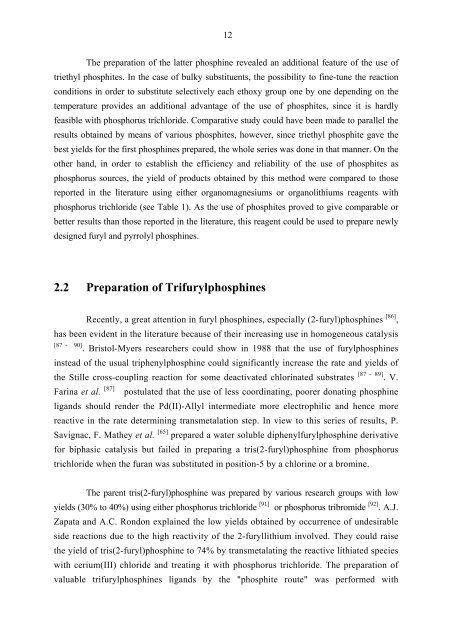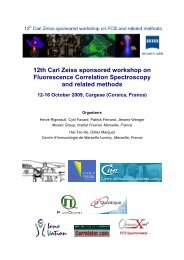My PhD dissertation - Institut Fresnel
My PhD dissertation - Institut Fresnel
My PhD dissertation - Institut Fresnel
Create successful ePaper yourself
Turn your PDF publications into a flip-book with our unique Google optimized e-Paper software.
12<br />
The preparation of the latter phosphine revealed an additional feature of the use of<br />
triethyl phosphites. In the case of bulky substituents, the possibility to fine-tune the reaction<br />
conditions in order to substitute selectively each ethoxy group one by one depending on the<br />
temperature provides an additional advantage of the use of phosphites, since it is hardly<br />
feasible with phosphorus trichloride. Comparative study could have been made to parallel the<br />
results obtained by means of various phosphites, however, since triethyl phosphite gave the<br />
best yields for the first phosphines prepared, the whole series was done in that manner. On the<br />
other hand, in order to establish the efficiency and reliability of the use of phosphites as<br />
phosphorus sources, the yield of products obtained by this method were compared to those<br />
reported in the literature using either organomagnesiums or organolithiums reagents with<br />
phosphorus trichloride (see Table 1). As the use of phosphites proved to give comparable or<br />
better results than those reported in the literature, this reagent could be used to prepare newly<br />
designed furyl and pyrrolyl phosphines.<br />
2.2 Preparation of Trifurylphosphines<br />
Recently, a great attention in furyl phosphines, especially (2-furyl)phosphines<br />
has been evident in the literature because of their increasing use in homogeneous catalysis<br />
[ 87 - 90 ]<br />
. Bristol-<strong>My</strong>ers researchers could show in 1988 that the use of furylphosphines<br />
instead of the usual triphenylphosphine could significantly increase the rate and yields of<br />
the Stille cross-coupling reaction for some deactivated chlorinated substrates [87 - 89] . V.<br />
Farina et al. [87] postulated that the use of less coordinating, poorer donating phosphine<br />
ligands should render the Pd(II)-Allyl intermediate more electrophilic and hence more<br />
reactive in the rate determining transmetalation step. In view to this series of results, P.<br />
Savignac, F. Mathey et al. [65] prepared a water soluble diphenylfurylphosphine derivative<br />
for biphasic catalysis but failed in preparing a tris(2-furyl)phosphine from phosphorus<br />
trichloride when the furan was substituted in position-5 by a chlorine or a bromine.<br />
The parent tris(2-furyl)phosphine was prepared by various research groups with low<br />
[ ]<br />
yields (30% to 40%) using either phosphorus trichloride 91 [ ]<br />
or phosphorus tribromide 92 . A.J.<br />
Zapata and A.C. Rondon explained the low yields obtained by occurrence of undesirable<br />
side reactions due to the high reactivity of the 2-furyllithium involved. They could raise<br />
the yield of tris(2-furyl)phosphine to 74% by transmetalating the reactive lithiated species<br />
with cerium(III) chloride and treating it with phosphorus trichloride. The preparation of<br />
valuable trifurylphosphines ligands by the "phosphite route" was performed with<br />
[ ] 86 ,













